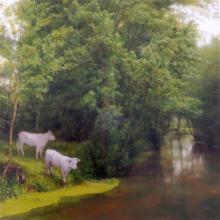
In Dark Arcadias at the Union Gallery this month, Edinburgh painter Keith Epps examines what he describes disarmingly as ‘one of the least original ideas in art – Et in Arcadia Ego – where the dark and painful exist within the light and beautiful.’
The trigger for this sequence (24 works) was TV coverage of the 1990s Yugoslav Wars. Here, Epps found it ‘hard to equate those ghastly events happening within such a beautiful setting’.
His paintings are beguilingly attractive (some – like 'Riverbank' above – recalling Constable), and the disturbances he introduces are never viscerally shocking. There is, for example, an easily missed corpse lying head and arms down beside the young tree on the riverbank in question.
His landscapes are accurate but not photo-realistic depictions of northern France, Devon, Sweden, Finland, Iceland and Scotland. Technically, they're brilliant but their effects are understated, soft-focus, imbued with a hard-to-define sense of both historic and potential loss. His real interest perhaps lies beyond incongruities of expectation and reality, pleasure and disgust, and more in how we narrate their order, causes and effects, where we find significance in them or whether there is even any meaning to be found.
In ‘Wreck No. 7’ (below), Epps paints a field under a grey sky, and in it a herd of Charolais. They surround the similarly hunkered mass of an abandoned tank. Indifferent to the weapon’s story, unmoved by its resonances, the herd ignores it and calmly waits for rain. To us, however, the tank in its ruined stillness speaks of a different downpour which once destroyed it.
Now, regardless of intention, cows and wreck are united by proximity, coincidental bulk and shape, this moment in their Time and our attention. One set looks forward and the other back. Future and past are linked, each unaware and uncomprehending of the other, balanced in this tense present.
Such sinuous timelines figure repeatedly in Epps’ work, adding complexity to his disconcerting revelations.
Take ‘Madam, Box Hill.’ It features a woman beside a tree, smiling as if in some everyday photograph. Meanwhile, above her in the branches, her mirror-image – faded, solemn – regards the viewer with equal candour. Is this a ghost, a memory, the projection of her private self, or some prefigurement?
Take ‘Road’, a seemingly uncomplicated path leading the eye from shaded right foreground to bright left background. The route meanders through meadow. The journey seems to offer hope.
So far so good. But if one obeys the impulse of a literate Westerner, one can’t help going back, re-reading that route from left to right. And now, on reaching a reinterpreted destination, one finds a line of bodies hidden under the trees. Journeys, and the assumptions we make in attributing to them beginnings and ends, turn out to be unreliable.
In ‘Crow’, a group of boys ascend a path through woods, their leader holding in his hands a bird. A little further on, another (or perhaps the same) group of boys, sticks raised, have formed a circle and are looking down at something in its centre. The two events may be simultaneous or sequential, but one knows for sure that the crow’s fate will unfold in precisely such a ring.
This painting – drawn from an incident in Epps’ own childhood – is also reminiscent of the boys filmed trailing through the hills above Srebrenica under escort. Again Epps blurs tenses and parallels, suggests that whatever storyline we think we participate in, it shimmers in and out of synch with others, is never fully ours to define.
Despite its imminent violence, ‘Crow’ is perhaps the clearest and most normal of Epps’ scenes here. His countryside is more often one of uncanny stillness, thickened hush. Its unsettling quiet lacks voices, birdsong, bees’ summer buzz. In fact, except for those white cattle, it lacks the living. It is like a world after plague, or a land which has been ethnically cleansed.
Bodies, human and mechanical, punctuate these landscapes with little pauses. They are not explicitly blood-soaked or revolting – not like corpses suddenly encountered in the war-fringed woods of Ambrose Bierce – but strangely peaceful. This, despite the cords which bind them to trees, the neat rows in which they are arranged, the clumsy sleeping attitudes into which they have tumbled.
There is no sound of terror, gun or grief. The SS and the Balkan militias have moved on out of frame. No-one but the paintings’ viewers see these humdrum dead, and we have no voice to tell or audience to hear us. The ruminating cows could not care less. Epps offers no apology, criticism or interpretation. His enormous cloud architectures obey their own unfolding logic and, for all their grandeur, contain not the slightest hint of divine presence or purpose.
It is this cumulative discomfiting absence which most characterises the exhibition. Epps makes one face the probability of our irrelevance. I won’t pretend to like that vision. It offers me no comfort. I prefer to believe otherwise ... and yet, and yet and yet ... he makes me think. AM
Keith Epps’ exhibition continues at the Union Gallery (45 Broughton Street) until 1 April. If you have a favourite work of art or exhibition in Broughton, we'd love to hear from you. Contact us by email at spurtle@hotmail.co.uk on Facebook Broughton Spurtle or Twitter @theSpurtle
-------------------------------------
@theSpurtle @UNIONgallery1 Pastoral idylls convey almost eternal natural beauty but with brief very human dark episodes, wonderful - go see!
